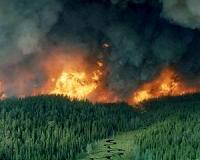 |
Washington DC (SPX) Dec 06, 2010 Scientists studying a column of Antarctic ice spanning 650 years have found evidence for fluctuations in biomass burning--the consumption of wood, peat and other materials in wildfires, cooking fires and communal fires--in the Southern Hemisphere. The record, focused primarily on carbon monoxide (CO), differs substantially from the record in the Northern Hemisphere, suggesting changes may be necessary for several leading climate models. The research appeared online in Science Express. The scientists studied variations in stable (non-radioactive, non-decaying) isotopes of carbon and oxygen, the first such measurements for carbon monoxide collected from ice-core samples. "Combined with concentration measurements of CO, this record allows us to constrain the relative strength of biomass burning activity over the 650-year period in the Southern Hemisphere," said co-author and research lead John Mak, a geoscientist at SUNY Stony Brook. "What we find is that the amount of biomass burning has changed significantly over that time period," Mak added, "and that biomass burning was in fact a significant source of CO during pre-industrial times." The biomass burning trends indicated by the CO largely agree with Southern Hemisphere records tracking charcoal particles in sediments and with measurements of methane from trapped ice. Unexpectedly, the researchers found that biomass burning appears to have been more prevalent 100 to 150 years ago than it was during the 20th century. "While this is consistent with previous findings," added Mak, "there is still a common mis-perception that biomass burning rates are much higher today than in the past. This is significant since many researchers assume that human-induced biomass burning is much greater than 'naturally' occurring biomass burning. "While this may still be the case--there were people around in the 18th century--the fact that today's rates of [Southern Hemisphere] biomass burning seem to be lower than one to two centuries ago calls for a re-evaluation of sources." The research was supported by NSF grant OCE-0731406. The full reference for the paper is: Z. Wang, J. Chappellaz, K. Park, J.E. Mak, "Large variations in Southern Hemisphere biomass burning during the last 650 years", Science, Dec. 2, 2010.
Share This Article With Planet Earth
Related Links National Science Foundation Forest and Wild Fires - News, Science and Technology
 Northern Wildfires Threaten Runaway Climate Change
Northern Wildfires Threaten Runaway Climate ChangeGuelph, Canada (SPX) Dec 06, 2010 Climate change is causing wildfires to burn more fiercely, pumping more greenhouse gases into the atmosphere than previously thought, according to a new study to be published in Nature Geosciences this week. This is the first study to reveal that fires in the Alaskan interior - an area spanning 18.5 million hectares - have become more severe in the past 10 years, and have released much mor ... read more |
|
| The content herein, unless otherwise known to be public domain, are Copyright 1995-2010 - SpaceDaily. AFP and UPI Wire Stories are copyright Agence France-Presse and United Press International. ESA Portal Reports are copyright European Space Agency. All NASA sourced material is public domain. Additional copyrights may apply in whole or part to other bona fide parties. Advertising does not imply endorsement,agreement or approval of any opinions, statements or information provided by SpaceDaily on any Web page published or hosted by SpaceDaily. Privacy Statement |